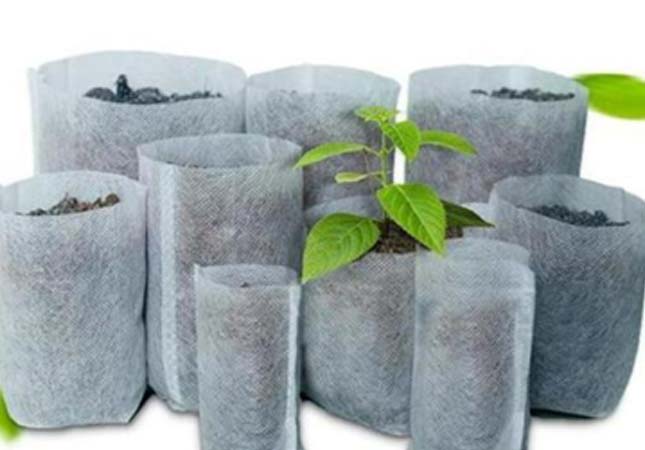Non woven cloth is a kind of eco-friendly material that composed of directional or random fibers by using special non woven machine. Non woven fabrics are moisture-proof, breathable, flexible, light, non-combustible, easy to decompose, non-toxic and non-irritating so that are found as perfect material as seedling bags in forestry field. Non woven fabrics usually are made by polypropylene (pp material) granules through the continuous one-step production method of high-temperature melting, spraying silk, laying outline, hot press rolled.
They are called cloth or fabric because of the similar appearance of common woven fabrics.
Why Use Non Woven Bags As seedling Bags?
With the modernization of the nursery concept, a good quality seedling containers and substrates have become the key factors for cultivating good seedlings.
In the past, the seedlings raised by the traditional method of using plastic bags as containers generally have poor root systems such as nesting, partial roots, thin roots and weak roots, which has become one of the important reason of the poor quality of plantation forests in China.
In the past, seedlings were raised by using plastic bags for growing then be transported into the ground or directly be planted on the ground , it resulted in the need to break the roots when transplanting after a long period of growth so that brought lots of inconvenience to the placts transplanting process and reduced the survival rate of plants greatly when transplanting. With the increase in the amount of seedling projects, changing the way of raising seedlings and vigorously developing seedlings bags have become the primary demand in forestry field.
The seedlings that raised by using plastic bags, hard plastic tubes and other impenetrable materials as containers with clay as substrates are bound to have abnormal root growth problems, which lead to the abnormal trees growth problems with poor anchorage and little space to absorb water and nutrients, finally caused of slow growth, poor resistance of all kinds diseases. The comprehensive consequence is to lead to small and old trees even lead to forestation failure if selected a incorrect seedling container.
However, the survival rate of seedlings grown in non woven seedling bags is higher and the trees grow significantly better than those grown in plastic seedling bags because the light substrate non-woven seedling bags eliminate the phenomenon of root entanglement of seedlings. And the seedlings will grow directly after entering the soil, and will rooted explosively if they have healing tissues formed after air-cutting. This is something that no other type of seedling container has been able to do so far. These root segments that are exposed to the outer containers and form healing tissue are constantly supplied with nutrients internally, creating a physiological state of buildup, also is more favorable than the formation of complex root masses in modern nursery concepts.

Advantages Of Non-Woven Seedling Bags
Non woven seedling bags have been promoted into forestry market since 2011. Compared with traditional plastic seedling bags, non-woven seedling bag not only realize the containerized cultivation management of seedlings, but also achieved no unpacking needs when transplanting. Non-woven fabric will decompose itself in the soil , which helps growers save time and labor cost, and the eco-friendly characteristic is popular among the engineering. It needed to raise the seedling only in spring or winter without seedling container in the past , but nowadays we can manage the seedling raise at any time period in the year, which meets the high and urgent requirements of urban greening.
1. Permeable & Breathable In Cultivation
Compared with plastic seedling bags, non woven seedling bags allow free penetration of water and nutrients without causing root rot by its excellent water permeability and air permeability, and also are convenient for maintenance. The root system of the plant is also not easy to surround with the main root only grows within the bag and the fine root absorb water and nutrients through the bag sides.
2. Save Time & Labor Cost In Transplanting
It is no longer affected by season and climate and can be transplanted throughout the year, which is especially beneficial for tree species that are difficult to transplant or have limited transplanting time. The substantial extension of transplanting time also helps to increase the sales for seedling manufacturers. In addition, it also reduces the cost of hiring technicians for enterprises to cut off the roots before transplanting since the roots of the plants do not penetrate into the ground.
There is no need to prune branches and leaves during transplanting, which can maintain the original tree appearance and improve the quality of the plant. The soil ball is not easy to loosen during transportation because of the intact root system of seedlings and the survival rate of the plants after transplantation can be increased to over 90%.




